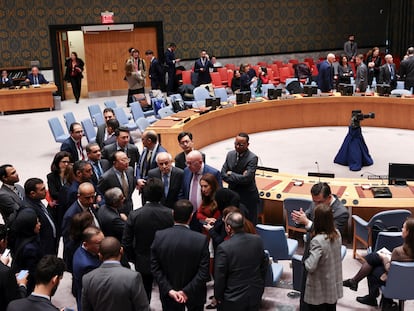Life in the Aida refugee camp amid Israel-Hamas war: ‘A graveyard of dreams for Palestinians’
The Israeli army, stationed behind the neighboring concrete wall, has stepped up raids and arrests in a community of 5,500 inhabitants, where half of the population are minors
“Aida is a graveyard of dreams for Palestinians,” says Said Zain, 25, dressed in black from top to bottom. “There are only two ways out of here: either you go crazy or you become very imaginative and creative.” He prefers the latter, and that is what he does as a psychologist at the Youth Center in the Aida refugee camp in the West Bank. He describes a string of calamities, all of which they encounter on a daily basis. But since the outbreak of war on October 7, this world of misfortune has gone from bad to worse, he says. Israeli military incursions, although less violent than in other West Bank camps such as Jenin or Tulkarem, take place several times a week.
So far this week, soldiers have been deployed on Monday and Tuesday. Residents show videos of those two days. The number of detainees in Aida since the outbreak of the war has reached almost 50, including some minors. In addition, a teenager was shot dead on November 10. The increasing level of violence and the military presence has almost completely stopped daily cultural, leisure, and sporting activities, especially among children, who represent around half of Aida’s population of around 5,500 people.
Among those arrested in recent days are the two heads of the Youth Center, who are also community leaders. On Monday night, uniformed officers took Munther Amari from his home after assaulting one of his brothers and locking his wife and children in an outbuilding, according to Zain. Amari is a well-known peace activist and member of the Popular Struggle Coordination Committee, a non-violent resistance movement in Palestine. Anas Abu Srour was taken away by the army on November 28. The two are being held under administrative detention, i.e. without charge or the right to a lawyer. “With the two of them detained, we are lost,” says Zain, underlining the work of Amari and Abu Srour in all kinds of relief work and keeping the inhabitants of Aida cohesive. “They are trying to provoke the collapse of the community, I think there is no other reason,” he concludes, resting his head on the computer keyboard.
“After October 7, arrests and raids have increased. Sometimes they enter the homes of the minors they have imprisoned [in Israel] and vandalize the place. The soldiers are being very aggressive. They feel they have impunity and that is very dangerous,” says Mohamed Alazaa, 33, director of the Lajee Cultural Center (which means “refugee” in Arabic). One of the sections of this Aida institution that has had to stop its activities is its soccer team, Lajee Celtic (or Aida Celtic), which takes its name from its association with the Green Brigade supporters’ group of Glasgow Celtic, an openly pro-Palestinian fan base.
During a UEFA Champions League match in 2016, the Green Brigade greeted Israeli side Hapoel Be’er Sheva with Palestinian flags. They were fined €10,000 ($10,979), but the Green Brigade managed to raise more than €200,000 ($219,590). Part of that money was donated to Aida Celtic. One of the seven watchtowers on the Israeli wall looks out over the artificial turf where smoke canisters have been fired in recent days, as Alazaa points out. “Out of responsibility, we had to stop,” he says as he rubs a scar that a gunshot left on his face in 2013, when he peered over the balcony of the cultural center. But it is not only the Israeli army siege that worries the people of Aida, Alazaa acknowledges, with one eye on Gaza. “There is no point in maintaining our normal life with what is happening there.”
“We are all considered terrorists”
“Here, the situation has always been very bad: arrests, destruction of homes, lack of privacy, shooting, tear gas... But since that day [October 7], everything has gotten worse. We young people are a danger at military checkpoints, we are all considered terrorists, so I am much more afraid than before,” explains Zain. Last month, he was shocked to learn how the military had arrested his neighbor, Jader Lofti, a father of three daughters. They blindfolded him, tied him up, forced him to his knees and repeatedly punched him in the stomach until he collapsed while one of them filmed the whole thing. Afterwards, to the scorn of his family and the residents of Aida, they posted it on social networks. “If they are capable of doing this in front of the camera, imagine what they do behind,” he says while playing the footage.
A huge black key on an arch in the shape of a lock welcomes you to the Aida camp, just outside Bethlehem. The sculpture represents the expulsion of Palestinians from their homes in the 1948 Nabka, when the State of Israel was born, and their determination to return. But beyond the key, the whole of Aida is a grating reminder that, although 75 years have passed and the original tents have made way for brick houses, it is a temporary settlement. The 0.71-kilometer space granted in 1950 by the United Nations agency for Palestinian refugees (UNRWA) to settle just over 1,000 expellees from a score of villages is the same plot of land on which some 5,500 people are crowded today.
“I was born here and grew up here,” says Said Zain. “My grandfather was expelled from Jerusalem and, although we are only seven kilometers away, I have never set foot in it in my life. I haven’t seen the sea either. That is my dream.” Yet another one buried in that grave he referred to. He is aware that the beach is only 50 kilometers (31 miles) away, but it is an insurmountable distance for someone who, like him, lives under Israeli occupation. “Many mornings I wake up and think, why did this life happen to me?” he says. His priority right now, however, is trying to pull through for the children, whose already complicated living conditions under normal circumstances have been worsened by the war. “They are traumatized and the best way to treat them would be to take them out of this environment, but that is impossible. There is no possibility for them to receive proper treatment,” he says, referring to the impasse in which they live.
Of the 236 inhabitants of Aida who took part in a 2017 study by the University of California, Berkeley, 100% claimed to have been subjected to tear gas. Residents say that now, smoke canisters are launched almost daily. The large number of shells fired by the Israeli army led a local jeweler to use them to make items such as pendants or souvenir earrings that he sells in his store, which is called The Key of Return.
A traditional Palestinian ceramic painting on the door of the Lajee Cultural Center indicates that Jerusalem is 7.8 kilometers (4.8 miles) away. A few meters in front of the building, the great concrete monster of the Israeli wall serves as a reminder that this distance today is falser than ever before, as the road has been cut off by the war. In the raid on the clubhouse on December 10, soldiers climbed up to the roof and tore down the Palestinian flag, including the flagpole. They then used the pole to fly an Israeli flag on the wall. “We had doubts about whether we should put it back up. There was some fear that they would come back again and cause damage or arrest someone. But that same day we put it back up. This one is even bigger,” Alazaa says defiantly, looking at the Israeli troop positions where the previous mast was taken. “And we have decided that, if they take it down again, we will fill all of Aida with Palestinian flags. It’s not just a flag; it’s the symbol of all Palestinians.”
Sign up for our weekly newsletter to get more English-language news coverage from EL PAÍS USA Edition
Tu suscripción se está usando en otro dispositivo
¿Quieres añadir otro usuario a tu suscripción?
Si continúas leyendo en este dispositivo, no se podrá leer en el otro.
FlechaTu suscripción se está usando en otro dispositivo y solo puedes acceder a EL PAÍS desde un dispositivo a la vez.
Si quieres compartir tu cuenta, cambia tu suscripción a la modalidad Premium, así podrás añadir otro usuario. Cada uno accederá con su propia cuenta de email, lo que os permitirá personalizar vuestra experiencia en EL PAÍS.
¿Tienes una suscripción de empresa? Accede aquí para contratar más cuentas.
En el caso de no saber quién está usando tu cuenta, te recomendamos cambiar tu contraseña aquí.
Si decides continuar compartiendo tu cuenta, este mensaje se mostrará en tu dispositivo y en el de la otra persona que está usando tu cuenta de forma indefinida, afectando a tu experiencia de lectura. Puedes consultar aquí los términos y condiciones de la suscripción digital.
More information
Archived In
Últimas noticias
Alain Aspect, Nobel laureate in physics: ‘Einstein was so smart that he would have had to recognize quantum entanglement’
Imelda Castro, the woman who wants to rule the cartel battleground of Sinaloa
The new victims of the Republican war on Obamacare: Millions hit by soaring health insurance premiums
A country divided on migrant rights: Some US states expand protections while others restrict them
Most viewed
- David King, chemist: ‘There are scientists studying how to cool the planet; nobody should stop these experiments from happening’
- Reinhard Genzel, Nobel laureate in physics: ‘One-minute videos will never give you the truth’
- Oona Chaplin: ‘I told James Cameron that I was living in a treehouse and starting a permaculture project with a friend’
- Sinaloa Cartel war is taking its toll on Los Chapitos
- Mexico completes its trade shift with the entry into force of tariffs on China and countries without trade agreements











































